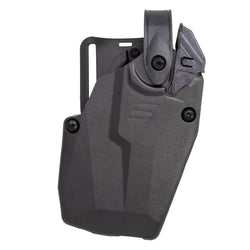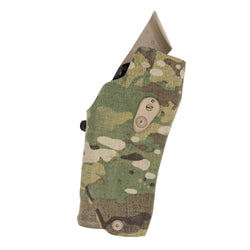Camouflage can be seen from two different perspectives. It can be examined from the person wearing it or the person or thing looking for what it hides.
The basics of camouflage have been presented in many ways over the years, and depending on where you study or who you hear it from, there will be certain overlap in the fundamentals.

From civilian hunting applications to military use, camouflage and sound tactics provide an advantage.
In this day and age, with stealth technology, night vision, and thermal devices, sometimes the basics are overlooked. It is easy to think of the most extreme cases of evasion and pursuit when the most common may take place in the daytime, under well-lit conditions, with little technology used to foil the efforts of the adversary.
In this article, we wanted to return to the fundamentals to discuss how they should be understood. A strong understanding of the basics leads to greater success in the field.
Shape
Our eyes are drawn to familiar shapes. We are good at identifying objects by their form. The mind has the capability of identifying what shapes are found in a given area and what shapes don’t belong with the baseline. Effective camouflage hides the shape of an object to blend into the surroundings.
When considering shape, think in both macro and micro terms. The human body has a familiar shape, as do vehicles. Hands are equally familiar in shape as are the wheels of a vehicle. Our minds are great at identifying what doesn’t belong in a given area. Man-made objects are easy to spot in the natural landscape without proper camouflage.

Spacing
Nature has an order, but it isn’t as ordered as man can make it. Trees and vegetation grow in different concentrations across the landscape. Landscapers may attempt to hide objects behind carefully planted trees, but the equal spacing draws the eyes to them, leading to closer examination.
A similar example is found with cell phone towers disguised as trees. While trees have certain growth patterns, the fake cell phone tree is too perfectly spaced. If you’re looking at something in the landscape that is spaced equal distances apart, there is a chance human touch was involved.

Shadow
Our eyes are drawn to dark places when scanning the landscape. Dark spaces indicate depth and potential hiding spots. If the terrain surveyed is mostly flat, a shadow can represent a cave, depression, or hole made in the ground.
When teaching survival courses, I make reference to the importance of creating a door or cover to the opening of a shelter if the students are looking to blend into the landscape. While black may be popular for ninjas in movies, there is simply no color found in nature as dark as black can be. Charcoal or dark grey is more effective than jet black for blending in.

Shade
Perhaps the easiest of the “S’s” to understand. What is worn for camouflage should be correctly shaded to blend in. The extreme examples are overwhites worn in the most tropical environments and midnight black uniforms worn in the desert/arid environments.
Certain color shades found in the middle of the spectrum have the most practical range. Think coyote brown, flat dark earth, ranger green, and olive drab. All of these colors can be found in most environments, and they will work better than brighter shades.

Symmetry
The human body is symmetrical, north to south. Looking at the micro features of the face, you will see symmetry working from the hairline to the jawline. The human brain makes connections very quickly, and even with a partial image of an object, the brain will fill in the missing pieces and complete the picture.
Irregular patterns in camouflage break up the symmetry in the object observed. The lines of the body are masked and obscured, and it’s more difficult for the brain to process the partial image as a whole.

Silhouette
When an object is silhouetted, it stands out against the backdrop. Skylining is an example of silhouette when the object on a ridgeline is contrasted against the open air.
Anyone who has shot a qualification course on a B-27 know exactly what a silhouette looks like. Silhouettes can give away position against an open space such as a field and lowering the vantage point to create a low-level skyline can help identify an object. Dropping to the prone position reduces silhouette whether you are stalking or being stalked.

Shine
Nature has reflective surfaces, and certain elements will bounce light. It isn’t uncommon for water to bounce sunlight across the landscape.
There are places where shine is expected and places where it logically shouldn’t be. Glass optics, brass zippers, gloss finish on metal, smooth flat surfaces commonly found on plastic items, all will create shine. Spray paint and fabric hockey tape work well for reducing shine.
Since light conditions are always changing, shine may exist during certain parts of the day but not in others. It is also possible that it can exist from one point of view but not from others. Shine is brighter than most dull surfaces on the landscape, and it draws our attention to it.

Sudden Movement
Prior to modern camouflage, deer hunters were highly effective by simply not moving. Movement will give away a position, whether our eyes are focused in on one area or our peripheral vision tends to recognize movement even more.
Sudden movement is a departure from the baseline. A tranquil woodland setting is disrupted by an animal darting through it. Certain animals will use micro terrain features to hide their movement, but others will move with abandon if they are pressured to take more risk.
Scent and Sound
While the focus of this blog is visual camouflage, two more “S”s to consider are scent and sound. A position can be given away with an odd scent. Campfires, smoking cigarettes, internal combustion engine exhaust, meals, and heavy cologne or perfume all have a scent that will travel with the wind.
Similarly, sound can cover great distances. Heavy footsteps, human or animal, and the corresponding rustling of leaves or sharp broken branches can alert a position. Metal clanging or jingling from zipper pulls, keys, or an empty water bottle clipped to a pack will all emit sound that will travel.

Countering scent requires awareness of the wind direction, eliminating human odors by masking them with natural scent, and adherence to strict discipline avoiding certain luxuries.
Sound discipline takes more effort to silence potential noise. Dangling objects need pockets, and packs need to be run slick. Some hunters will even remove boots and stalk closer to animals in neoprene socks to make more careful foot placement and avoid the heavy thump of soles on the ground. Self-awareness is ultimately critical.
Adapt and Blend
The most effective camouflage is what adapts to the environment it is in. It blends into the baseline. What works in a forest may not work well in the desert, and certainly won’t work in a concrete jungle.
Learning to adapt to surroundings is an ongoing study, and the fundamentals apply wherever you may roam.









